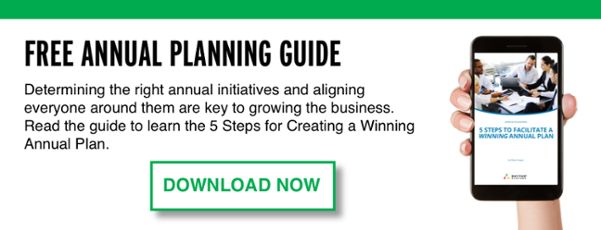Fall is upon us. School is back in session, the leaves are beginning to turn, the air is crisp, Pumpkin  Spice Lattes are back at Starbucks… and many, many Executive Teams are gathering in conference rooms for the yearly ritual of Annual Planning. In many cases they are clearing their schedules for two full days, traveling to a different location, and spending hours preparing ahead of time for this important event. Why is this such an important ritual?
Spice Lattes are back at Starbucks… and many, many Executive Teams are gathering in conference rooms for the yearly ritual of Annual Planning. In many cases they are clearing their schedules for two full days, traveling to a different location, and spending hours preparing ahead of time for this important event. Why is this such an important ritual?
According to an article in McKinsey Quarterly, "For those working in the overwhelming majority of corporations, the annual planning process plays an essential role. In addition to formulating at least some elements of a company’s strategy, the process results in a budget, which establishes the resource allocation map for the coming 12 to 18 months; sets financial and operating targets, often used to determine compensation metrics and to provide guidance for financial markets; and aligns the management team on its strategic priorities.”
To make this important process as effective as possible, your team must have discipline. You must spend the time to prepare well, prioritize the key discussions you must have to make the right decisions, and commit to leaving your session with a focused, execution-ready plan for the year and for the quarter.
In fact, the McKinsey article references the failure to execute strategy as a key problem with most annual planning processes:
In the end, many companies fail to execute the chosen strategy. More than a quarter of our survey respondents said that their companies had plans but no execution path. Forty-five percent reported that planning processes failed to track the execution of strategic initiatives. All this suggests that putting in place a system to measure and monitor their progress can greatly enhance the impact of the planning process.
Here’s what you need for a Focused, Execution-Ready Annual Plan:
- Main Thing: This is your theme for the year. Consider all the preparation you’ve done for your session, and crystallize a main thing to focus on as a company. Create a rallying cry, something easy to remember that will help communicate the goal for the year to the entire company. It doesn’t have to be “cute” - it just has to be focused and clear.
- Targets: These are the results you are hoping to achieve by the end of the year. Consider the 3-5 year targets you’ve set for your Company and think about where you need to be on those by the end of the year to stay on track. Typically, your targets will include key financial metrics (revenue, profit, etc.) and other goals that are important to your business (# of locations, # of customers, # of employees, etc.). Stick to a handful of KPIs for your annual targets (4-5), and use a dashboard to measure your targets weekly or monthly so you aren’t surprised by the results at the end of the year.
- Critical Numbers: Your Critical Numbers are a sub-set of your annual targets. Think about your Main Thing and how you will measure your success this year? Your main thing should have a corresponding KPI that is your Critical Number 1 for the year. Then, you should consider what might fall through the cracks if you were overly focused on Critical Number 1. This is your Critical Number 2. Keep these special KPIs top of mind using dashboards as well.
- Annual Initiatives: This is where the discipline comes in. You can’t successfully execute too many things in a year. You need to focus on 3-5 initiatives that will drive your company strategy forward. Consider your revenue growth strategies or Winning Moves and what you need to do this year to move forward on them. Align your initiatives with your main thing and targets. Consider your resources and the timing and bandwidth of your teams. Be thoughtful and prepare well to have the right discussions to choose your roadmap for the year wisely.
- Real-Time Visualization: You need to be able to see how you are doing on your Annual Plan throughout the year. You will waste your two-day planning session if you don’t have a way to communicate the plan to the company, break it down into quarterly execution sprints, monitor progress, and adjust your execution as needed. Consider using an intelligent work platform like Rhythm to drive successful execution of your business strategy for the year.
While you may not have the discipline to avoid the onslaught of Halloween candy and holiday sweets, following our annual planning process will improve the changes that you have the discipline to be successful in achieving your business plan for next year.
Looking for more Annual Planning information to help get you started? Check out our additional resources:
Annual Planning: 9 Tips to Focus & Align Your Team with a Great Plan
Annual Planning Playbook: 5 Steps to Create a Winning Annual Plan
How CEOs Can Avoid High-Cost Mistakes in Annual Planning
Best Practices for Annual Planning
How to Conduct an Annual Planning Meeting
Rhythm Systems Annual Planning Resource Center
Photo Credit: iStock by Getty Images
Photo Credit: iStock by Getty Images



 LinkedIn
LinkedIn
 Facebook
Facebook
